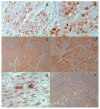Integrative Histologic and Bioinformatics Analysis of BIRC5/Survivin Expression in Oral Squamous Cell Carcinoma
- PMID: 30205554
- PMCID: PMC6174346
- DOI: 10.3390/ijms19092664
Integrative Histologic and Bioinformatics Analysis of BIRC5/Survivin Expression in Oral Squamous Cell Carcinoma
Abstract
Survivin is a well-known protein involved in the inhibition of apoptosis in many different cancer types. The aim of this study was to perform an integrated bioinformatic and histologic analysis in order to study the expression and prognostic role of Survivin and its related gene BIRC5 in oral cancer. Publicly available databases were accessed via Gene Expression Omnibus and Oncomine, in addition raw data from The Cancer Genome Atlas (TCGA) were also obtained in order to analyze the rate of gene mutation, expression and methylation in patients with oral squamous cells carcinoma (OSCC). Immunohistochemistry (IHC) was also performed in order to evaluate the nuclear and cytoplasmic expression of Survivin and their correlation with cell proliferation in samples from OSCC patients. Results of this study revealed that Survivin is rarely mutated in OSCC samples and upregulated when compared to non-cancerous tissue. A negative correlation between the methylation of the island cg25986496 and BIRC5 mRNA expression was detected from TCGA data. IHC staining revealed that cytoplasmic (and not nuclear) expression of Survivin is associated with poor overall survival in OSCC patients, while the nuclear expression correlates with higher proliferation rate. In addition, data from TCGA database revealed that BIRC5 gene expression is an independent prognostic factor for OSCC patients.
Keywords: BIRC5; Survivin; TCGA; bioinformatic; immunohistochemistry; oral cancer.
Conflict of interest statement
The authors declare no conflict of interest.
Figures





Similar articles
-
Up-regulation of survivin in oral squamous cell carcinoma correlates with poor prognosis and chemoresistance.Oral Surg Oral Med Oral Pathol Oral Radiol Endod. 2010 Oct;110(4):484-91. doi: 10.1016/j.tripleo.2010.04.009. Oral Surg Oral Med Oral Pathol Oral Radiol Endod. 2010. PMID: 20868995
-
Nuclear survivin promoted by acetylation is associated with the aggressive phenotype of oral squamous cell carcinoma.Cell Cycle. 2017 May 3;16(9):894-902. doi: 10.1080/15384101.2017.1310352. Epub 2017 Apr 6. Cell Cycle. 2017. PMID: 28384094 Free PMC article.
-
An integrated methylation and gene expression microarray analysis reveals significant prognostic biomarkers in oral squamous cell carcinoma.Oncol Rep. 2018 Nov;40(5):2637-2647. doi: 10.3892/or.2018.6702. Epub 2018 Sep 12. Oncol Rep. 2018. PMID: 30226546 Free PMC article.
-
Quality Assessment of Prognostic Studies Using Cancer Stem Cell Markers in Oral Squamous Cell Carcinoma.Appl Immunohistochem Mol Morphol. 2018 May/Jun;26(5):e61-e69. doi: 10.1097/PAI.0000000000000569. Appl Immunohistochem Mol Morphol. 2018. PMID: 28800012
-
Cancer therapeutics using survivin BIRC5 as a target: what can we do after over two decades of study?J Exp Clin Cancer Res. 2019 Aug 22;38(1):368. doi: 10.1186/s13046-019-1362-1. J Exp Clin Cancer Res. 2019. PMID: 31439015 Free PMC article. Review.
Cited by
-
Exploring the druggable space around the Fanconi anemia pathway using machine learning and mechanistic models.BMC Bioinformatics. 2019 Jul 2;20(1):370. doi: 10.1186/s12859-019-2969-0. BMC Bioinformatics. 2019. PMID: 31266445 Free PMC article.
-
The Influence of Adalimumab and Cyclosporine A on the Expression Profile of the Genes Related to TGFβ Signaling Pathways in Keratinocyte Cells Treated with Lipopolysaccharide A.Mediators Inflamm. 2020 Jul 26;2020:3821279. doi: 10.1155/2020/3821279. eCollection 2020. Mediators Inflamm. 2020. PMID: 32774143 Free PMC article.
-
Krüppel-like factor 5 promotes the progression of oral squamous cell carcinoma via the baculoviral IAP repeat containing 5 gene.Ann Transl Med. 2022 Sep;10(18):969. doi: 10.21037/atm-22-3728. Ann Transl Med. 2022. PMID: 36267746 Free PMC article.
-
Bioinformatics analysis of BIRC5 in human cancers.Ann Transl Med. 2022 Aug;10(16):888. doi: 10.21037/atm-22-3496. Ann Transl Med. 2022. PMID: 36111008 Free PMC article.
-
Identification of potential key genes in gastric cancer using bioinformatics analysis.Biomed Rep. 2020 Apr;12(4):178-192. doi: 10.3892/br.2020.1281. Epub 2020 Feb 20. Biomed Rep. 2020. PMID: 32190306 Free PMC article.
References
-
- Tuyns A.J., Esteve J., Raymond L., Berrino F., Benhamou E., Blanchet F., Boffetta P., Crosignani P., del Moral A., Lehmann W., et al. Cancer of the larynx/hypopharynx, tobacco and alcohol: IARC international case-control study in Turin and Varese (Italy), Zaragoza and Navarra (Spain), Geneva (Switzerland) and Calvados (France) Int. J. Cancer. 1988;41:483–491. doi: 10.1002/ijc.2910410403. - DOI - PubMed
MeSH terms
Substances
LinkOut - more resources
Full Text Sources
Other Literature Sources
Medical

